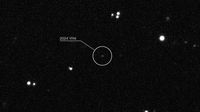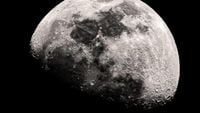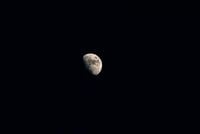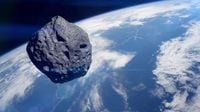In a cosmic tale that has captured the attention of scientists and the public alike, the asteroid 2024 YR4, dubbed the "city killer" due to its potential for destruction, has made headlines again as new observations clarify its trajectory. Discovered in December 2024, the asteroid initially raised alarms about a possible impact with Earth, but recent updates from NASA indicate that our planet is safe from collision. However, the Moon may not be as fortunate.
NASA's latest assessments have revealed that the probability of 2024 YR4 hitting Earth has plummeted to nearly zero, with estimates now at just 0.001%. This significant reduction in risk comes after detailed observations made by the James Webb Space Telescope (JWST), which have provided clearer insights into the asteroid's size and composition. Andy Rivkin, a researcher at Johns Hopkins University, noted that the asteroid measures approximately 60 meters in diameter, equivalent to a 15-story building.
Initially, estimates suggested that 2024 YR4 had up to a 3.1% chance of colliding with Earth, a figure that understandably caused concern among scientists. Fortunately, further analysis has confirmed that Earth is no longer at risk. However, the Moon remains a potential target, with the probability of impact now estimated at 3.8% as of early April 2025.
Gilles Dawidowicz from the French Astronomical Society explained the implications of a lunar impact, stating, "It would create a small explosion that might be visible from Earth, particularly if it occurs on the visible side of the Moon. If it happens at night, it could even be seen with the naked eye, though that’s not guaranteed." He emphasized that the impact would not pose a threat to Earth.
NASA's monitoring efforts have been crucial in keeping track of 2024 YR4's movements. The agency utilized the advanced capabilities of the JWST to conduct urgent observations, confirming that while the risk to Earth is eliminated, the Moon still faces a slight chance of being struck. The asteroid's trajectory will bring it close to both Earth and the Moon in December 2032, making it a focal point for ongoing studies.
The JWST's observations have not only confirmed the asteroid's size but also indicated that it may be more rocky than initially believed. This information is vital as it helps scientists understand the potential consequences of an impact. If 2024 YR4 were to collide with the Moon, the energy released would be equivalent to 340 Hiroshima bombs, a staggering thought that underscores the importance of continued monitoring.
Alan Fitzsimmons, a professor at Queen's University Belfast, expressed hope for a lunar impact, stating, "We’re keeping our fingers crossed for a lunar impact. It wouldn’t affect Earth, but it would allow us to study a phenomenon in real-time." Such an event would provide a unique opportunity to observe crater formation on the Moon, an occurrence that has not been documented with an object of this size before.
As scientists plan for a second round of observations with the JWST in May 2025, they aim to refine their predictions and better understand the asteroid's characteristics. The JWST's infrared sensors have proven invaluable, allowing astronomers to gather data on the asteroid's heat emissions, which are not detectable by ground-based telescopes. This capability enables researchers to assess the asteroid's reflectivity and composition more accurately.
Despite the current reassurances, the scientific community remains vigilant. The potential for future impacts from asteroids is a reality that cannot be ignored. The DART (Double Asteroid Redirection Test) system, designed to deflect threatening asteroids, is always on standby as a precautionary measure.
In summary, while 2024 YR4 poses no threat to Earth, its potential to impact the Moon invites a mix of caution and curiosity. The ongoing observations and analyses will not only enhance our understanding of this particular asteroid but also improve our preparedness for any future celestial threats.
As the scientific community continues to monitor 2024 YR4, the lessons learned from this asteroid will contribute to our broader understanding of near-Earth objects and the measures needed to protect our planet from potential dangers. The story of 2024 YR4 is a reminder of the vastness of space and the unpredictable nature of the universe, compelling us to remain watchful and informed.







